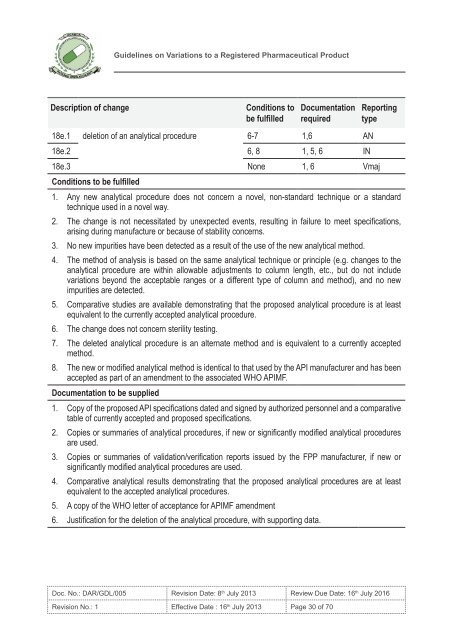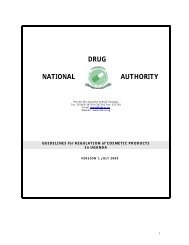guidelines on variations to a registered pharmaceutical product
guidelines on variations to a registered pharmaceutical product
guidelines on variations to a registered pharmaceutical product
- No tags were found...
Create successful ePaper yourself
Turn your PDF publications into a flip-book with our unique Google optimized e-Paper software.
Guidelines <strong>on</strong> Variati<strong>on</strong>s <strong>to</strong> a Registered Pharmaceutical ProductDescripti<strong>on</strong> of changeC<strong>on</strong>diti<strong>on</strong>s <strong>to</strong>be fulfilledDocumentati<strong>on</strong>required18e.1 deleti<strong>on</strong> of an analytical procedure 6-7 1,6 AN18e.2 6, 8 1, 5, 6 INReportingtype18e.3 N<strong>on</strong>e 1, 6 VmajC<strong>on</strong>diti<strong>on</strong>s <strong>to</strong> be fulfilled1. Any new analytical procedure does not c<strong>on</strong>cern a novel, n<strong>on</strong>-standard technique or a standardtechnique used in a novel way.2. The change is not necessitated by unexpected events, resulting in failure <strong>to</strong> meet specificati<strong>on</strong>s,arising during manufacture or because of stability c<strong>on</strong>cerns.3. No new impurities have been detected as a result of the use of the new analytical method.4. The method of analysis is based <strong>on</strong> the same analytical technique or principle (e.g. changes <strong>to</strong> theanalytical procedure are within allowable adjustments <strong>to</strong> column length, etc., but do not includevariati<strong>on</strong>s bey<strong>on</strong>d the acceptable ranges or a different type of column and method), and no newimpurities are detected.5. Comparative studies are available dem<strong>on</strong>strating that the proposed analytical procedure is at leastequivalent <strong>to</strong> the currently accepted analytical procedure.6. The change does not c<strong>on</strong>cern sterility testing.7. The deleted analytical procedure is an alternate method and is equivalent <strong>to</strong> a currently acceptedmethod.8. The new or modified analytical method is identical <strong>to</strong> that used by the API manufacturer and has beenaccepted as part of an amendment <strong>to</strong> the associated WHO APIMF.Documentati<strong>on</strong> <strong>to</strong> be supplied1. Copy of the proposed API specificati<strong>on</strong>s dated and signed by authorized pers<strong>on</strong>nel and a comparativetable of currently accepted and proposed specificati<strong>on</strong>s.2. Copies or summaries of analytical procedures, if new or significantly modified analytical proceduresare used.3. Copies or summaries of validati<strong>on</strong>/verificati<strong>on</strong> reports issued by the FPP manufacturer, if new orsignificantly modified analytical procedures are used.4. Comparative analytical results dem<strong>on</strong>strating that the proposed analytical procedures are at leastequivalent <strong>to</strong> the accepted analytical procedures.5. A copy of the WHO letter of acceptance for APIMF amendment6. Justificati<strong>on</strong> for the deleti<strong>on</strong> of the analytical procedure, with supporting data.Doc. No.: DAR/GDL/005 Revisi<strong>on</strong> Date: 8 th July 2013 Review Due Date: 16 th July 2016Revisi<strong>on</strong> No.: 1 Effective Date : 16 th July 2013 Page 30 of 70
















